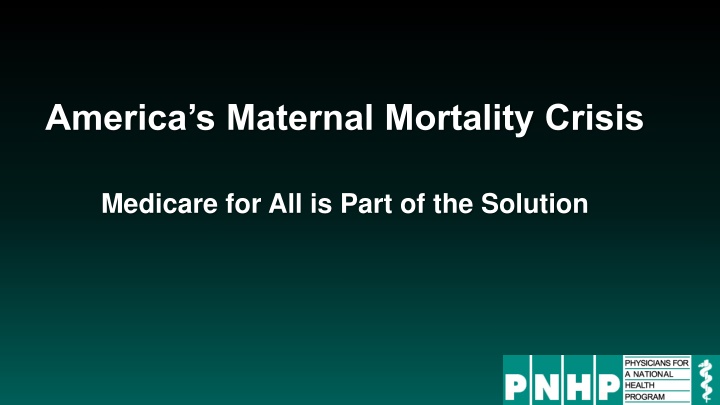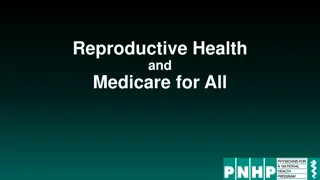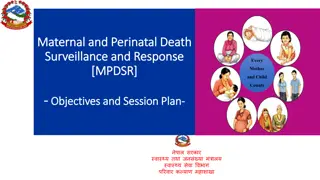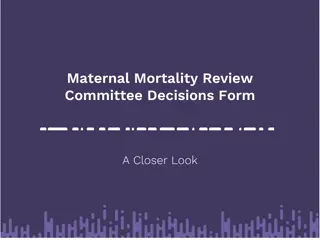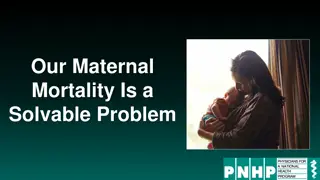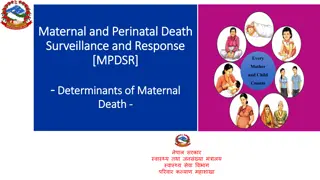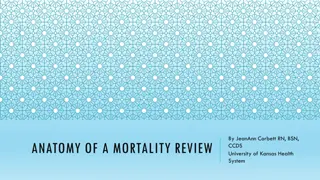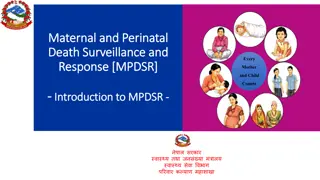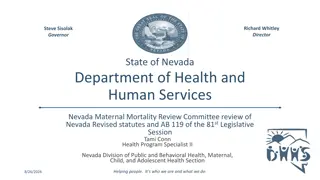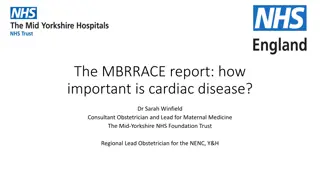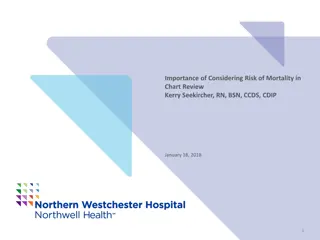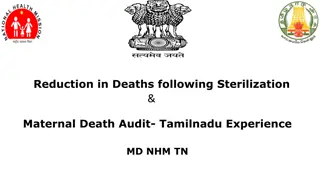Maternal Mortality Crisis in the U.S.: Urgent Need for Healthcare Reform
Maternal mortality rates in the United States have significantly increased over the years, with racial disparities exacerbating the issue. The data shows a concerning rise in both maternal and infant mortality, highlighting the critical need for comprehensive healthcare reform to address these alarming trends. Medicare for All is proposed as a key solution to combat the maternal mortality crisis and improve maternal and infant health outcomes nationwide.
Download Presentation

Please find below an Image/Link to download the presentation.
The content on the website is provided AS IS for your information and personal use only. It may not be sold, licensed, or shared on other websites without obtaining consent from the author.If you encounter any issues during the download, it is possible that the publisher has removed the file from their server.
You are allowed to download the files provided on this website for personal or commercial use, subject to the condition that they are used lawfully. All files are the property of their respective owners.
The content on the website is provided AS IS for your information and personal use only. It may not be sold, licensed, or shared on other websites without obtaining consent from the author.
E N D
Presentation Transcript
Americas Maternal Mortality Crisis Medicare for All is Part of the Solution
Maternal Mortality Much Higher in the U.S. 33 Maternal deaths per 100,000 live births 11 10 8 7 7 5 4 4 3 2 NOR AUS GER NET SWE SWI NZ FRA UK CAN US Maternal mortality: Death while pregnant or within 42 days of the end of pregnancy, irrespective of the duration and site of the pregnancy, from any cause related to or aggravated by the pregnancy or its management, but not from accidental or incidental causes. Used by the World Health Organization (WHO) in international comparisons. Date for 2021 or 2020 where available. Source: Trends in maternal mortality 2000 to 2020: estimates by WHO, UNICEF, UNFPA, World Bank Group and UNDESA/Population Division
Maternal Mortality More Than Quadrupled in U.S. 2021 = 33 Pregnancy -related deaths per 100,000 live births 1987 = 7 1987 1992 1997 2002 2007 2012 2017 2021 Pregnancy-related death: Death during pregnancy or within one year of the end of pregnancy from a pregnancy complication, a chain of events initiated by pregnancy, or the aggravation of an unrelated condition by the physiologic effects of pregnancy. This CDC measure is used in the U.S. only. https://www.cdc.gov/nchs/data/hestat/maternal-mortality/2021/maternal-mortality-rates-2021.htm; Accessed Sept. 6, 2023
Maternal Mortality Compounded by Racial Inequities 70 Maternal deaths per 100,000 live births (2021) 28 27 White Hispanic Black Hoyert DL. Maternal mortality rates in the United States, 2021. NCHS Health E-Stats. 2023. DOI: https://dx.doi.org/10.15620/cdc:124678 Accessed Sept. 6, 2023
Infant Mortality Higher in the U.S. 5.4 4.5 Deaths in first year of life per 1,000 live births 3.6 3.2 3.1 2.4 2.4 Italy Sweden Germany Australia France Canada USA Source: OECD 2022. Note: Data are for 2021 or most recent year available
Infant Mortality Compounded by Racial Inequities 10.6 Infant Mortality per 1,000 live births, 2019 8.2 7.9 5.0 4.5 3.4 Asian White Hispanic AIAN NHOPI Black AIAN = American Indians and Alaskan Natives NHOPI = Native Hawaiians and Other Pacific Islanders https://www.cdc.gov/reproductivehealth/maternalinfanthealth/infantmortality.htm
Maternal Mortality Is a Solvable Problem Preventable 84% 84% of U.S. Maternal Deaths are Preventable https://www.cdc.gov/reproductivehealth/maternal-mortality/erase-mm/data-mmrc.html
U.S. Women Already Behind on Care 38% of women skipped medical care due to costs in past year. 44% of women report serious problems paying medical bills in past year. https://www.commonwealthfund.org/publications/issue-briefs/2018/dec/womens-health-us-compared-ten-other-countries#append4 Data for 2018.
Less than half of uninsured get early prenatal care 94% 79% Started prenatal care in first trimester 49% Employer/ Private Insurance Medicaid Uninsured https://www.macpac.gov/wp-content/uploads/2018/11/Pregnant-Women-and-Medicaid.pdf Insurance status characterized by both prenatal care and delivery
Racial Inequities in Prenatal Care 20% Late or no prenatal care 13% 10% 8% 5% 4% White Asian Hispanic Black AIAN NHOPI AIAN = American Indians and Alaskan Natives; NHOPI = Native Hawaiians and Other Pacific Islanders. Data for 2018 https://www.kff.org/report-section/racial-disparities-in-maternal-and-infant-health-an-overview-issue-brief/
Increasing OOP Spending for Maternity Care $5,161 $4,314 $3,364 2008 $2,910 2015 Vaginal Birth Cesarean Birth Data source: Moniz MH, Fendrick AM, Kolenic GE, Tilea A, Admon LK, Dalton VK. Out-Of-Pocket Spending For Maternity Care Among Women With Employer-Based Insurance, 2008 15. Health Affairs 2020;39(1):18 23.
Rural Counties Losing Hospital OB Services 641 591 641 608 591 Number of hospitals w/ OB services 453 7 Million U.S. women of child-bearing age live in counties with no or limited maternity care 2004 2014 Rural Micropolitan (10-50,000) Rural NonCore (<10,000) http://rhrc.umn.edu/wp-content/files_mf/1491501904UMRHRCOBclosuresPolicyBrief.pdf https://www.marchofdimes.org/research/maternity-care-deserts-report.aspx
2.2 million women in counties with No OB, Hospital, or Birth Center Maternity care deserts Low access to maternity care Moderate access to maternity care Full access to maternity care 2020 report at https://www.marchofdimes.org/materials/2020-Maternity-Care-Report.pdf
When An Area Loses OB Services Out-of-hospital births increase Infant mortality rate doubles Preterm births increase https://www.ruralhealthweb.org/NRHA/media/Emerge_NRHA/Advocacy/Policy%20documents/01-16-19-NRHA-Policy- Access-to-Rural-Maternity-Care.pdf
Most Maternal Deaths Occur After Baby Is Born 31% % of maternal deaths 21% 19% 17% 12% During pregnancy Day of delivery Days 1-6 postpartum Days 7-42 postpartum Days 43-365 postpartum Data 2011-2015 https://www.commonwealthfund.org/publications/issue-briefs/2020/nov/maternal-mortality-maternity-care-us-compared-10-countries
Most Maternal Deaths Occur After Baby Is Born 4 1 0 W.H.O. recommends 4+ postpartum visits U.S. parents typically have 1 office-based postpartum visit 40% of American births have no postpartum visits https://journals.lww.com/greenjournal/Fulltext/2018/05000/ACOG_Committee_Opinion_No__736__Optimizing.42.aspx
Postpartum Home Visits Covered by National Health Plans Daily if needed until day 10, plus 16 visits as needed until 8 weeks Daily up to 10 days postpartum Daily, starting day 1 and up to day 10; minimum of 4 hours per day Within week 1, typically one to three visits Contacted or visited within 24 48 hours Starting within 24 hours, one to three visits At least 5 visits over 6 weeks, starting within 48 hours First visit during week 1, then every 1-2 weeks until week 8 At least until 10 days postpartum None required by law. Office visits covered by some insurers and state Medicaid programs Germany Switzerland Netherlands Australia Canada France New Zealand Sweden UK U.S. https://www.commonwealthfund.org/publications/issue-briefs/2020/nov/maternal-mortality-maternity-care-us-compared- 10-countries
Health Coverage Reduces Maternal Mortality For every 100,000 people covered, Medicaid expansion states had: 4 fewer deaths among white parents 6 fewer deaths among Hispanic parents 16 fewer deaths among Black parents https://www.whijournal.com/article/S1049-3867(20)30005-0/fulltext#fig1
Medicaid a Band-aid, not a Cure Among those who gave birth with Medicaid: 27% were uninsured before pregnancy 21% did not receive care in first trimester 22% uninsured again 2-6 months postpartum
Medicare for All Can Help Solve Our Maternal Health Crisis Racial inequities Fragmented coverage Poor access to OB providers Lack of postpartum care
Medicare for All: Addressing Racial Inequities Provide equitable and universal coverage proven to improve outcomes for people of color Invest significant resources in underserved communities Provide training for health professionals to combat racial bias Establish a national Office of Health Equity to fund research and data collection on racial inequity
Medicare for All: Unifying Fragmented Health System Provide everybody in the U.S. with seamless, lifelong coverage including preconception, pregnancy, & postpartum care. Manage chronic conditions and prevent unintended pregnancies, improving pregnancy outcomes and overall health.
Medicare for All: Improving Access to OB Care Providers would be attracted to under-served areas by creating an entire nation of people with insurance Providers could spend more time in direct patient care (and be happier) because they ll spend farless time dealing with insurance Global budgets would fund hospitals in rural and low-income communities based on community needs
Medicare for All: Covering All Postpartum Care Postpartum care would be universally available (as would the rest of healthcare) No insurance company would be able to get in the way of necessary care Birth control options to prevent unwanted or closely-spaced pregnancies
Medicare for All addresses the Root Causes of U.S. Maternal Mortality Crisis Today s problems Racial inequities Fragmented coverage Medicare for All s solutions Equitable universal coverage, track disparate outcomes, and promote care for today s underserved Chronic conditions managed over a lifetime, not only during pregnancy. No copays or deductibles to get in the way Universal coverage draws providers into underserved areas; Global budgets protect rural hospitals. Lack of providers Reliably covered for everybody, regardless of race, ethnicity, income, or geography. Coverage is lifelong and seamless. Lack of post- partum care
